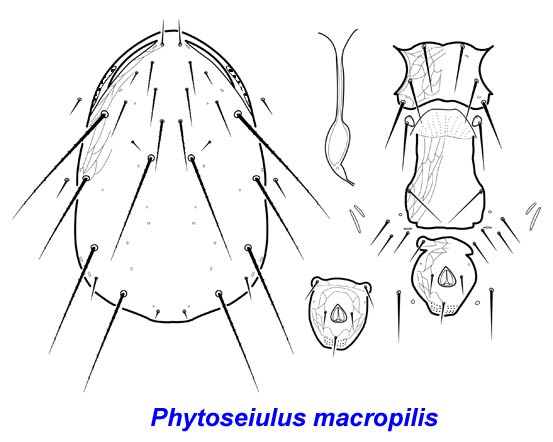Taxonomic Position
Cohort Gamasina
Subcorhort Dermanyssiae
Superfamily Phytoseioidea
Family Phytoseiidae Berlese
Phytoseiulus macropilis (Banks)
(synonyms: P. speyeri Evans, P. chanti Ehara, Typhlodromus macrosetis Hirschmann)
Diagnostic characters of adult female:
-
Dorsal shield ca. 0.300-0.325 mm long
-
Dorsal shield setae j5 and S5 both present, j5 barbed and reaching insertion of j6; j6 barbed and as long or longer than Z1; R1 and r3 simple, similar in length
-
Peritrematal shield fused to dorsal shield anteriorly
-
Fixed digit of chelicera elongate and with row of 7-8 teeth
-
Calyx of spermatheca vase-shaped with neck of variable length
-
Sternal shield with 3 pairs of setae; st4 on small platelets
-
Anal opening usually on ventrianal shield with 5 setae; however, antero-lateral margins of the shield may be eroded and one or both setae JV2 in the soft cuticle
-
Ventral setae JV4 absent
-
Genu IV with barbed macroseta (ca. 0.075 mm long); macroseta on basitarsus IV barbed (ca. 0.110 mm long)

Similar species. P. longipes has a sternal shield with only 2 pairs of setae (st1-2) and lacks dorsal shield setae j5 and S5. P. fragariae has simple setae j6 shorter than Z1 and setae JV4 present laterad the ventrianal shield. P. macropilis usually has a ventrianal shield with 4-5 setae (rarely an anal shield with 3 setae) and a barbed macroseta on basitarsus IV. P. persimilis always has an anal shield and has a simple macroseta on basitarsus IV.
Ecology & Distribution. Phytoseiulus macropilis is known from the United States, Brazil, the Canary Islands, Africa, and the Cook Islands, Hawaii, Fiji, French Polynesia, Moto Quavarei, New Caledonia and Tahiti in the Pacific Ocean.
References
Banks N. 1905. Descriptions of some new mites. Proceedings of the Entomological Society of Washington 7: 133-142.
Schicha e.
1987. Phytoseiidae of
Australia and Neighbouring Areas. (Indira Publishing House, Oak Park, Michigan, USA.)
Schuster RO & Pritchard EA. 1963. Phytoseiid mites of California. Hilgardia 43: 191-285.
Takahashi F & Chant DA. 1993. Phylogenetic relationships in the genus Phytoseiulus Evans (Acari: Phytoseiidae). II. Taxonomic Review. International Journal of Acarology 19: 23-37.
Tseng YH. 1976.
Systematics of the mite family Phytoseiidae from Taiwan, with a revised
key to the genera of the world (II). Journal
of the Agricultural Association of China 94: 86-128.